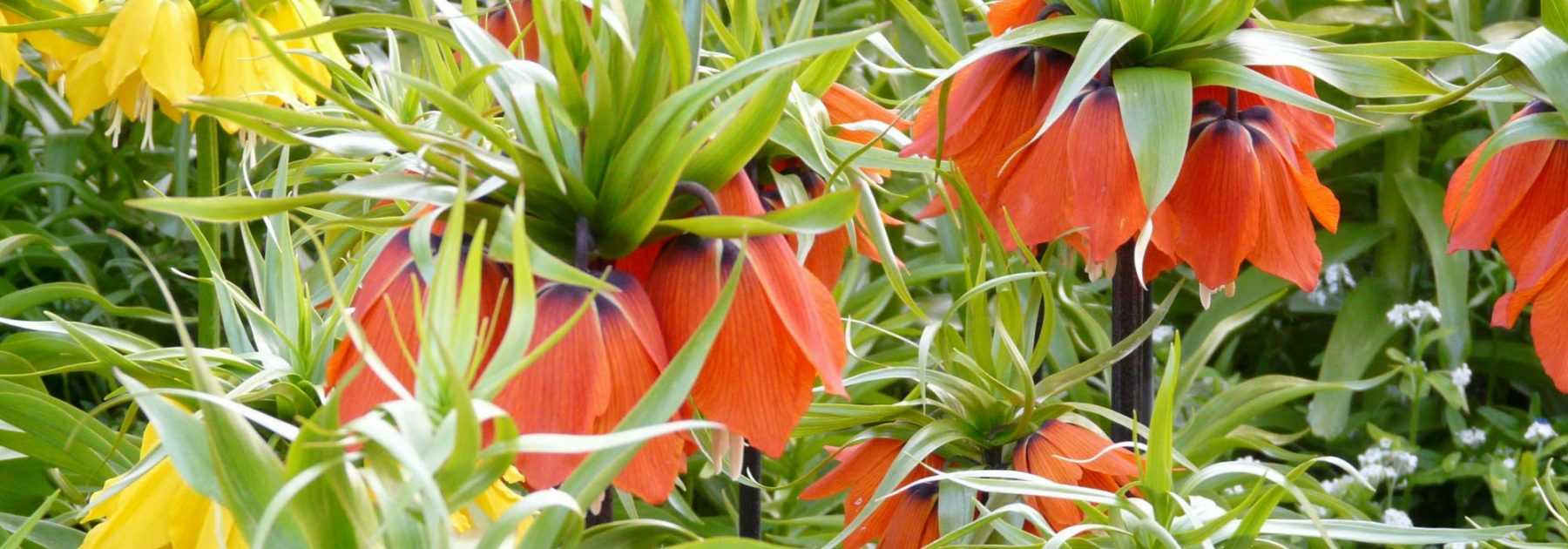
Fritillary: Planting, Growing and Care Guide
Contents
Fritillaries in a Nutshell
- Their spring flowering is truly spectacular
- They thrive in full sun or partial shade
- They’re the ultimate mole-repellent bulbs
- Easy to grow in well-drained soil
- Hardy bulbs that remain in the ground for many years
Our expert's word
Alongside rare and wild species like the Pyrenean Fritillary, there are tolerant and easy-to-grow varieties of Fritillaries that thrive in our gardens. If Fritillaria imperialis brings to mind the crown imperial in a copper vase, immortalised in Vincent Van Gogh’s famous painting, this striking and architectural spring bulb is equally eye-catching in the garden.
From March for the earliest varieties through to May, their bell-shaped flowers—typically red-orange, purple, sometimes white or checkered—emerge from grassy clumps to herald spring.
Whether they are Fritillaria imperialis, Snake’s Head Fritillary, Persian Fritillary, or Fritillaria uva-vulpis, their spring blooms never go unnoticed. Ranging from 20 cm to 1.5 m in height, fritillaries can be planted almost anywhere—in borders, pots, along pathways, beneath deciduous trees, in rockeries, or even scattered across lawns—depending on their growing requirements.
The Crown Imperial, or Fritillaria imperialis, has long been used as a mole deterrent. This beautiful repellent emits a strong scent from the soil that keeps rodents at bay, but that’s not its only asset: it’s one of the tallest spring bulbs!
With their distinctive, structured silhouette and crown-like yellow or orange flowers, Crown Imperials add height and exotic flair to the back or centre of flower beds. Smaller varieties like Fritillaria michailovskyi thrive along sunny borders, in rockeries, or in containers.
In dappled shade or non-scorching sun, they flourish in most gardens, with some naturalising easily over time to form flowering clumps. In mid-spring, they create striking or simple displays alongside other spring bulbs like daffodils, wood anemones, hyacinths, or tulips.
Discover all their planting and care tips, as well as our Fritillary collections, including some very rare and exclusive varieties—perfect for transforming a sunny border, brightening a rockery, flowering a shady woodland edge, or creating stunning spring planters.
Botany
Botanical data
- Latin name Fritillaria
- Family Liliaceae
- Common name Fritillary, Crown Imperial, Snake's Head Fritillary
- Flowering March to June
- Height 0.15 to 1.50 m
- Exposure Sun, partial shade
- Soil type ordinary well-drained
- Hardiness -5°C to -15°C depending on species
The Fritillaria genus comprises around a hundred species of bulbous perennials native to temperate regions of the Northern Hemisphere, particularly the Mediterranean basin, southwest Asia and western North America. They belong to the Liliaceae family, like lilies, squills or daffodils.
Fritillaries include numerous species divided into tall Fritillaries with stems reaching 1.50 m in height, medium-sized ones between 40 and 70 cm, and small fritillaries not exceeding 20 cm tall. All bloom in spring.
In our gardens, there are about fifteen cultivated species offering gardeners a very eclectic choice, both in terms of widely varying cultivation requirements from one species to another and in appearance. Fritillaries’ needs are so different that we generally distinguish the most tolerant species from those native to woodlands that prefer moist soil and small species that cannot tolerate moisture.
All adapt very well to our climates. The best-known and most commonly planted is undoubtedly the Crown Imperial Fritillary, native from southern Turkey to Kashmir, with yellow or orange crown-shaped flowers and attractive light green or white or gold variegated foliage. It now comes in about ten varieties with rich colours, including the essential Fritillaria imperialis Aureomarginata and Crown Imperial ‘Rubra’.
We also find Fritillaria meleagris, called “Snake’s Head Fritillary” or “Guinea Hen Flower”, with their pretty white or strongly chequered bells and the tall white or black Persian fritillaries.
Fritillaria bucharica with star-shaped flowers, Fritillaria uva vulpis, Fritillaria michailovskyi and Fritillaria hermonis ssp. Amana are small bulbs of less common or rarer species. Some, like the “Snake’s Head Fritillary” or wild fritillaries, are now protected species in their natural habitat.
The bulbs of fritillaries, of varying sizes, have at least two scales and sometimes numerous bulbils at the base. Growing in spring, the bulbs go dormant and rest in summer, indifferent to heat and drought. As long as the soil suits them and they are not disturbed, they multiply over time, faithfully reblooming each year on slopes, in rockeries or borders.
Despite their majestic appearance, fritillaries are excellent repellents: they are the ultimate mole-repellent bulb! Once underground, their large bulbs emit an unpleasant odour within a 1.5 m radius that repels rodents.
They form more or less upright clumps depending on the species, from which emerge rigid stems 0.15 to 1.50 m tall. The deciduous leaves measure from 2 to 20 cm long. They are bright green, dark green to grey-green, sometimes shiny or rough. Some varieties have attractive bright green foliage variegated with golden yellow. Each bulb produces linear, alternate, lanceolate leaves, sometimes narrow. They are longer at the base and more or less numerous along the flower stem. They can be well spaced on the stem and become scarcer at the top. “Snake’s Head Fritillaries” develop grass-like foliage.
Some, like the imperialis, are topped with a tuft of upright green leaves above the flowers, giving them a beautiful exotic appearance: a plume that earns this species the name “Crown Imperial”. After flowering, the leaves yellow and collapse onto the ground, then the foliage quickly disappears in summer, leaving the bulb dormant underground.
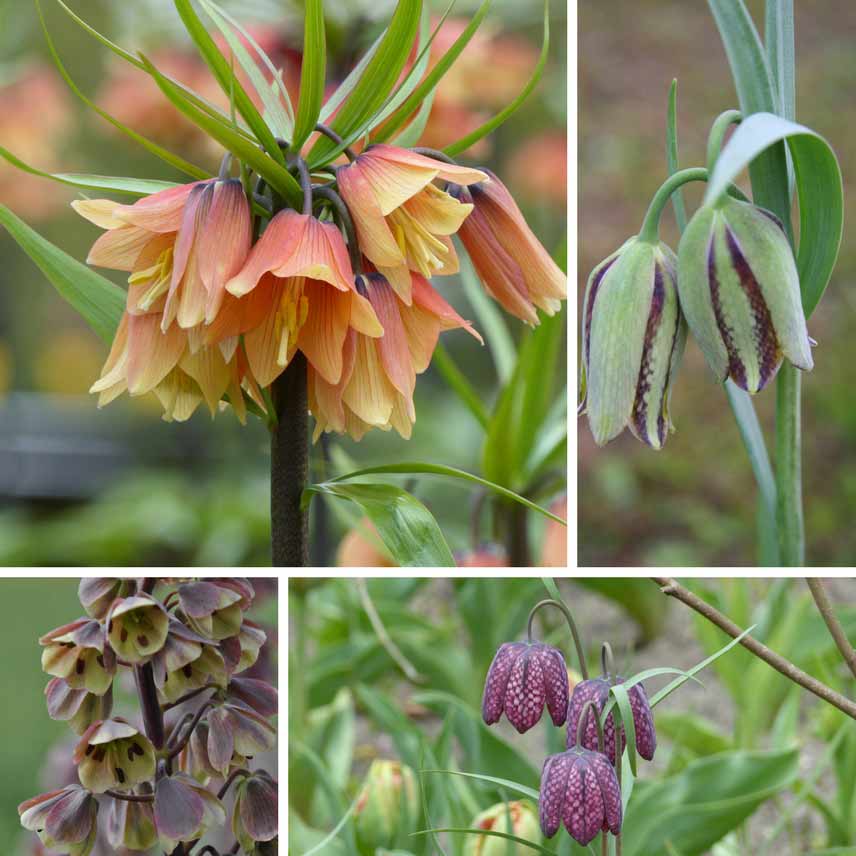

Fritillaria imperialis ‘Orange beauty’ – Fritillaria hermonis ssp. amana – Fritillaria persica Bicolor – Snake’s Head Fritillary or Fritillaria meleagris
The extraordinary early flowering of fritillaries never goes unnoticed. It begins in March, at the same time as daffodils and the first tulips, peaking in April and ending in May with the arrival of summer heat. Fritillaries are among the first large bulbs to flower in spring.
The flowers appear singly or in pairs of 2 or 3 or in spikes of 20 to 30 flowers or in a crown at the end of upright stems. They take the form of pendulous bells delicately veined and sometimes swollen, 4 to 5 cm in diameter, or star-shaped flowers. Some have flower stalks over 30 cm long.
The centre of the petals of the Crown Imperial contains nectaries, i.e. stamens producing drops of nectar, hence the nickname “flower that weeps”.
The unscented flowers come in colours ranging from dark almost black, purple or green, to flamboyant orange, yellow or red-orange, sometimes silvery white or cream in the case of Fritillaria imperialis Raddeana.
Fritillaria meleagris, called ‘Snake’s Head Fritillary’, has a particularly recognisable flowering with bells printed with a subtle chequerboard of dark purplish pink or greenish-yellow. Some are beautifully contrasted, like Fritillaria uva vulpis with its deep red flowers edged with golden yellow and Fritillaria hermonis ssp. amana whose green petals are alternately tinged with a discreet plum chequerboard.
After flowering, the flowers dry and form fruit in the form of capsules, often winged and very decorative, which release tiny black seeds that self-sow.
Most of these spring-flowering bulbs are hardy and withstand cold very well down to -10-15°C, easy to grow, provided the soil is very well drained and the location warm and sunny, but not necessarily in direct sun. They like fertile soils. Apart from woodland and moist meadow species, they thrive ideally in continental climates where winters and summers are dry and springs moist.
Majestic and imposing, Fritillaries inevitably catch the eye when planted in groups. The tallest species structure and add height to the centre and back of beds or mixed borders with tulips or late cream or white daffodils.
They will show to best advantage when combined with medium-sized shrubs like lilacs, deciduous azaleas or Japanese kerria. Varieties with flamboyant flowers shine in warm colour combinations like peach or apricot with orange and scarlet.
The muted tones of some fritillaries pair well with pink, mauve, white or blue flowers of Siberian squills, grape hyacinths or primroses, for example, and with the purple leaves of heucheras. They are splendid alongside hostas and early-flowering euphorbias.
Small fritillaries brighten up any gravel or rock garden, a sunny border or a raised bed, provided their elegant nodding flowers can be admired up close. They also naturalise in lawns or at the foot of deciduous trees. They can be grown in pots to enjoy them even on the terrace.
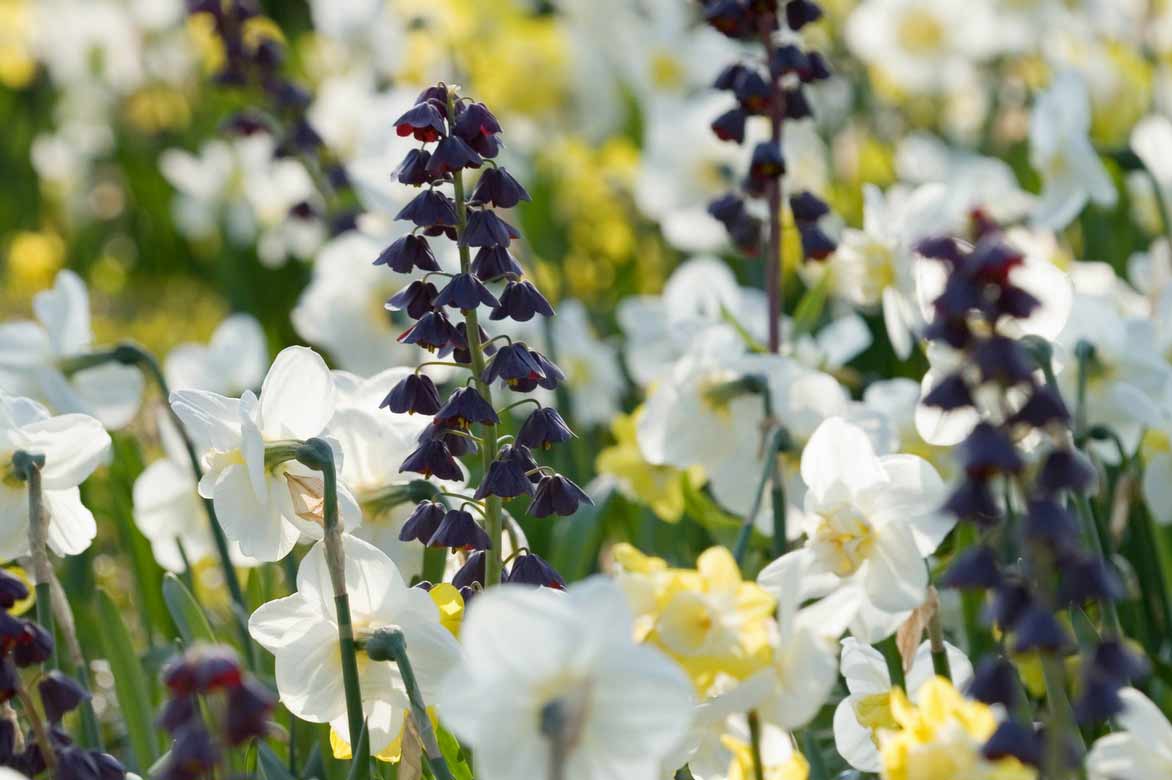

The sturdy tall stems of Fritillaria persica Adiyaman are accompanied by lower-growing plants so their graphic foliage and characteristic pendulous flowers can be admired from all angles
Read also
Planting spring bulbs lateSpecies and varieties
The Fritillaries have been classified into 4 groups according to their cultivation requirements. They also differ in the height of their stems, ranging from 15 cm for the smallest species to nearly 1.50 m for the tallest, such as the Crown Imperial or Fritillaria imperialis.
- Group 1: These are species resistant to cold and tolerant of summer drought, such as the Crown Imperial (Fritillaria imperialis) and its cultivars, the Persian Fritillary (Fritillaria persica), the Pale-flowered Fritillary (Fritillaria pallidiflora), Fritillaria uva-vulpis, and Radde’s Fritillary (Fritillaria raddeana). They enjoy full sun but absolutely require fertile, very well-drained soil! They thrive in sunny flower beds or rock gardens.
- Group 2: These are fairly hardy species like Fritillaria acmopetala, but they cannot tolerate rain during their dormancy period and therefore prefer dry soils in summer. They love the sun and thrive in very well-draining, less fertile soil. They are ideal for rock gardens, raised beds, or even greenhouses.
- Group 3: These are species native to damp forests and meadows, such as the Snake’s Head Fritillary (Fritillaria meleagris) and the Kamchatka Fritillary (Fritillaria camschatcensis). They should be planted in full sun or light shade, in fertile soil that retains moisture well in summer. They are best grown in regions with cool, damp summers. These are the easiest and probably the least demanding.
- Group 4: This group includes smaller species like Fritillaria michailovskyi and the Amana Fritillary (Fritillaria hermonis ssp. amana), which cannot tolerate moisture. They should be grown in full sun in fresh, fertile, well-drained soil, protected from rain, ideally under a cold frame or in an unheated greenhouse to keep the bulbs dry during their dormancy period.
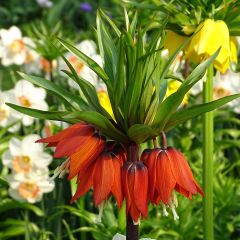
Fritillaria imperialis Rubra
- Flowering time May, June
- Height at maturity 80 cm
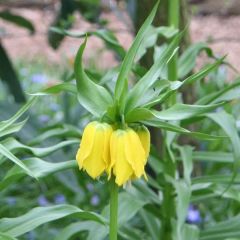
Fritillaria imperialis Lutea
- Flowering time May, June
- Height at maturity 90 cm
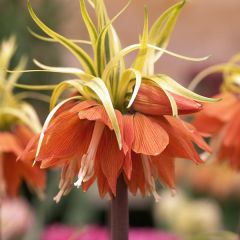
Fritillaria imperialis Aureomarginata
- Flowering time May
- Height at maturity 75 cm
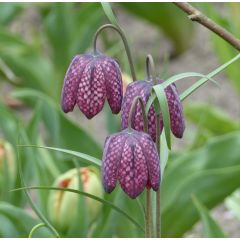
Fritillaria meleagris - Snake's Head Fritillary
- Flowering time April, May
- Height at maturity 25 cm
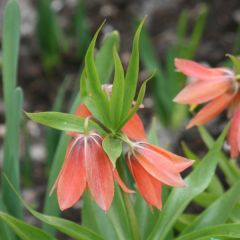
Fritillaria imperialis Bach
- Flowering time May, June
- Height at maturity 70 cm
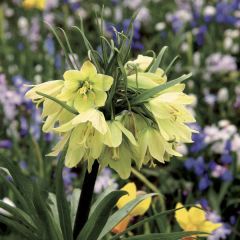
Fritillaria raddeana
- Flowering time May
- Height at maturity 80 cm

Fritillaria persica Ivory Bells
- Flowering time May, June
- Height at maturity 70 cm
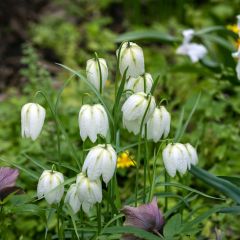
Fritillaria meleagris Alba
- Flowering time April, May
- Height at maturity 25 cm
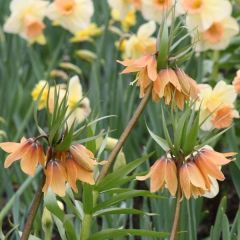
Fritillaria imperialis Tchaikovsky
- Flowering time May, June
- Height at maturity 60 cm
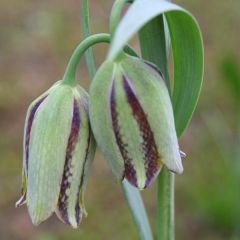
Fritillaria hermonis subsp. amana
- Flowering time May, June
- Height at maturity 25 cm
Discover other Fritillaria
Planting
Where to Plant?
Depending on the species, Fritillaries have very different needs. Most prefer to be planted in full sun or light shade in fertile, very well-drained soil.
They thrive, with the exception of moisture-loving species, ideally in continental climates where winters and summers are dry and springs are wet.
Versatile, Fritillary bulbs suit all garden settings and will naturalise in light woodland, at the foot of deciduous trees and shrubs, on slopes, along pathways, in rockeries. Allow their foliage to die back completely before cutting it.
With their architectural form, taller species like the Crown Imperial and Persian Fritillary should be planted sheltered from strong winds, at the back or centre of borders where they add height and striking focal points.
Smaller fritillaries like Fritillaria uva-vulpis and Fritillaria michailovskyi are easy to grow and fit effortlessly into borders, rockeries or containers.
Moisture-loving species like the Snake’s Head Fritillary should be planted in woodland where they’ll naturalise easily or perhaps near a pond.
Grow moisture-sensitive species in containers or a greenhouse, sheltered from rain.
After flowering, Fritillaries quickly wither, displaying faded foliage that can be concealed by planting them with hardy geraniums, lungworts or euphorbias.
Fritillary bulbs emit a strong scent and act as effective rodent repellents; they’re traditionally planted among tulip beds whose bulbs are highly prized by small mammals.
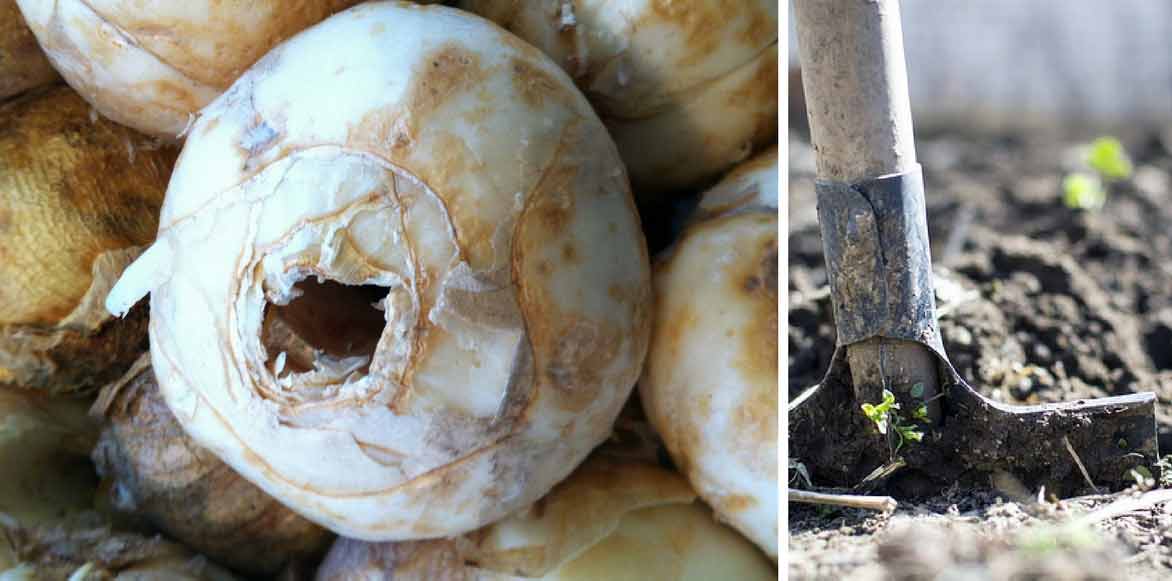

The large hollow bulbs of Fritillaria imperialis retain moisture and are highly prone to rot if drainage is insufficient
When to Plant
Ideally, Fritillary bulbs should be planted in early autumn, September-October, especially for delicate imperialis varieties which deteriorate rapidly out of soil. Other fritillaries can be planted up until November.
How to Plant
Promptly after purchase! Fritillary bulbs are prone to drying out and rotting, so plant them without delay in rich, very well-drained soil as fritillaries detest waterlogging and heavy soils, which encourage fungal growth.
A tip: before planting, always check the specific cultivation needs of your chosen species, as these vary. Varieties like Fritillaria meleagris, which prefer cool, heavy soils, should be planted in borders or damp rockeries, beneath shrubs or in lawns.
In open ground
Tall Fritillaries should be planted in small groups of 3 or 5 maximum for a natural look. Smaller varieties like Fritillaria meleagris deserve mass planting (up to 100 bulbs per m²), in lightly mown lawns or as flowering carpets beneath deciduous shrubs for spectacular effect.
- Loosen soil deeply with added organic matter (bulb fertiliser)
- In heavy soil, improve drainage with gravel or pumice mixed into soil or placed as a 5-10cm layer beneath bulbs
- Plant carefully at 3x bulb height (10-20cm deep), tip upwards (plant hollow Fritillaria imperialis bulbs at an angle to prevent rot)
- Space large bulbs 30cm apart, small ones 10cm apart, avoiding contact
- Cover bulbs with soil
- Keep dry in summer
- Leave bulbs in place – they’ll reflower annually
Mass planting
Certain small fritillaries like Fritillaria meleagris naturalise easily. Planted en masse, they’re perfect for creating floral displays around the house, in borders, woodland edges or beneath trees. For mass planting, allow 50-100 bulbs per m². Dig a 20cm-deep area, space bulbs 5-10cm apart, then backfill.


Fritillaria meleagris naturalise effortlessly beneath trees, forming beautiful floral carpets over the years
In pots
Fritillary bulbs grow well in containers for spring displays on patios or balconies.
- Place clay pebbles in the base of a pierced pot (preferably terracotta) for perfect drainage
- Fill with a light, well-draining mix: half garden soil, quarter leaf mould, quarter grit or pumice
- Plant bulbs 20cm deep, covering with 3x their height in soil
- Water weekly during growth, stopping in summer when foliage yellows
→ Learn more in our guide: Growing Crown Imperials in pots.
Care and Maintenance
Fritillaries are accommodating plants that require little care. In windy areas, don’t hesitate to stake taller species if needed. Water only during the growth period, keep the bulbs dry during summer; except for moisture-loving Fritillaries, leave them undisturbed and stop all watering during their summer dormancy period.
No pruning is necessary, though to limit self-seeding you may cut flower stems after blooming. Only mow or cut back foliage to ground level when completely withered, allowing the bulb time to rebuild reserves for next season’s flowering.
Potted specimens will need regular fertilising and repotting every two years in autumn: after flowering, apply bulb fertiliser or organic fertiliser.
In very cold regions, mulch the soil surface with dried leaves to protect bulbs from frost. Some varieties like Fritillaria michailovskyi aren’t very hardy and require winter protection from cold and damp with good mulching.
Fritillary clumps lose vigour with age and often disappear within three years: after 4 years, flowering becomes sparse. Don’t hesitate to apply organic fertiliser at the base of clumps every 3 years when leaves emerge.
Pests and potential diseases
Fritillaries are hardy bulbous perennials resistant to diseases in well-drained soil. Apart from excess moisture causing bulb rot, they are mainly threatened by gastropods that feast on their young leaves even before they emerge from the ground in spring. Slug treatment, applied at planting time and then every year from February onwards, is essential.
Fritillaries have another known and dreaded enemy: the lily beetle, a small red beetle that loves the scent emitted by fritillaries and devours leaves and flower buds, sometimes completely defoliating the plant.
Check for its presence on your plants as soon as growth resumes; it appears from March until late July. Remove by hand and crush the adult insects. You can sprinkle garlic powder around the base of plants or spray tansy manure, early in the season and up until flowering, before the lily beetle emerges from the soil. An oily solution based on garlic and rapeseed oil, sprayed onto the plants, will kill eggs and larvae. Repeat applications frequently until flowering.
Propagation
Fritillaries can be propagated by sowing seeds or separating bulbils in late summer, once the foliage has completely dried. It will take 5 or 6 years for a plant grown from seed to flower, and 3 years to achieve a good flowering from a plant grown from bulb division or offsets. Fritillary seed germination is slow and unpredictable, especially since a plant grown from seed will take several years to flower, and some species readily self-seed naturally. We recommend division, which is very simple to do.
Separating Bulbils
Fritillaries multiply quickly by producing bulbils. After 3 or 4 years, you can divide the clumps and separate the bulbils formed around the mother bulb. Be patient: flowering will only occur after 3 years.
- Carry out the process in late summer when the leaves have yellowed
- Dig up the clump with a garden fork
- Gently separate the bulbs by hand or with a small knife
- Replant them immediately in the ground or temporarily in pots filled with a mix of sand and compost
- Water sparingly
→ Also discover how to propagate bulbs by scaling in our tutorial!
Pair with
Versatile, Fritillaria bulbs are exceptionally easy to pair and thrive alongside equally low-maintenance plants. Depending on the species, they make either bold architectural statements or luminous yet subtle accents, flourishing in mid-spring within naturalistic gardens without full-time gardeners, weekend retreats, or adding height and striking form to exotic-style borders.
They create alternately flamboyant, spectacular scenes as backdrops or focal points, or delicate, fresh compositions in borders and rockeries with purple or white tones.
Different Fritillaria species suit varied settings: taller varieties planted en masse create stunning effects in well-drained beds, while smaller types thrive scattered through woodland, lawns, pathway edging, sunny rockeries or spring containers.
The intense orange or vivid red of a sculptural Crown Imperial group pairs beautifully with warm apricot/peach tones of early tulips like Willem van Oranje, while the slender spikes of dark purple Fritillaria persica complement blood-red Greigii tulip ‘Red Riding Hood’. Yellow Fritillaries dazzle alongside Viridiflora tulips.
Muted Fritillary tones harmonise exquisitely with blue Siberian squills or muscari.
These charismatic bulbs also thrive alongside other equally undemanding bulbs – wood anemones, hyacinths, camassias, glory-of-the-snow, spring starflowers, ornamental alliums, reticulated iris or dog’s-tooth violets.
The vivid yellow-green blooms of early-flowering euphorbias accentuate the mahogany bells of Fritillaria michailovskyi, as would a backdrop of golden Japanese kerria pompons.
Fritillaries’ distinctive foliage and flowers shine alongside mid-sized shrubs like lilacs, deciduous azaleas or blue-toned Japanese maples. They create striking contrasts with early-leafing hostas and purple heuchera foliage.
For springtime exotic-inspired borders, combine the curiously segmented foliage of Fritillaria imperialis with generous, graphic perennials like artemisias or Hungarian bear’s breech.
Smaller species suit gravel gardens, rockeries, sunny beds or raised planters near terraces, mingling with snowdrops and hellebores for early spring admiration.
Fritillaria meleagris thrives in damp rockeries, containers, under deciduous trees or beside ponds accompanied by perennials like astilbes, Siberian irises or marsh spurge for layered blooms. It naturalises beautifully in lawns.
Moisture-sensitive types like Fritillaria bucharica excel in container cultivation – sheltered in conservatories or balconies alongside pansies, miniature cyclamen, narcissi, crocuses, hyacinths or primroses.
Useful resources
- Our Spring Bulbs Planting Depth Guide
- The most beautiful and rarest fritillaries are available here: discover our collection!
- Advice sheet: Bulb Sizes: Understanding How to Choose
- Advice sheet: 6 Bulbs to Naturalise in Your Garden
- Advice sheet: 4 Repellent Plants to Deter Moles
- Advice sheet: Botanical Fritillaries, the Most Beautiful Varieties
- Advice sheet: How to Choose a Fritillary?
- Subscribe!
- Contents
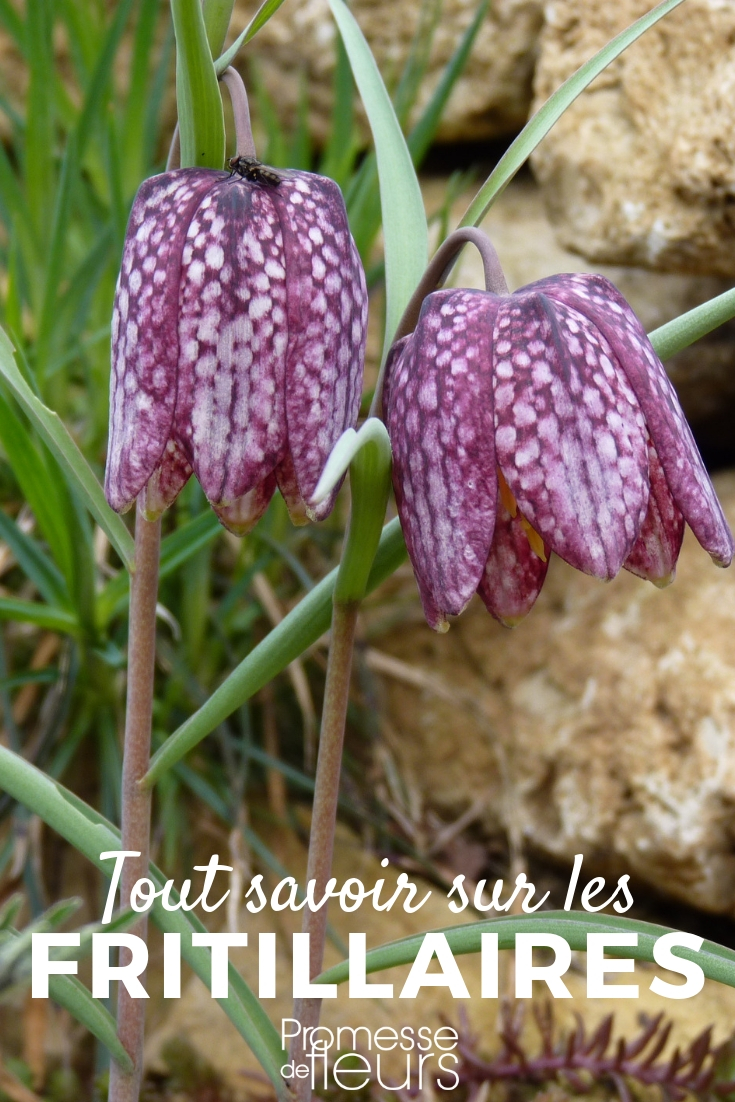


































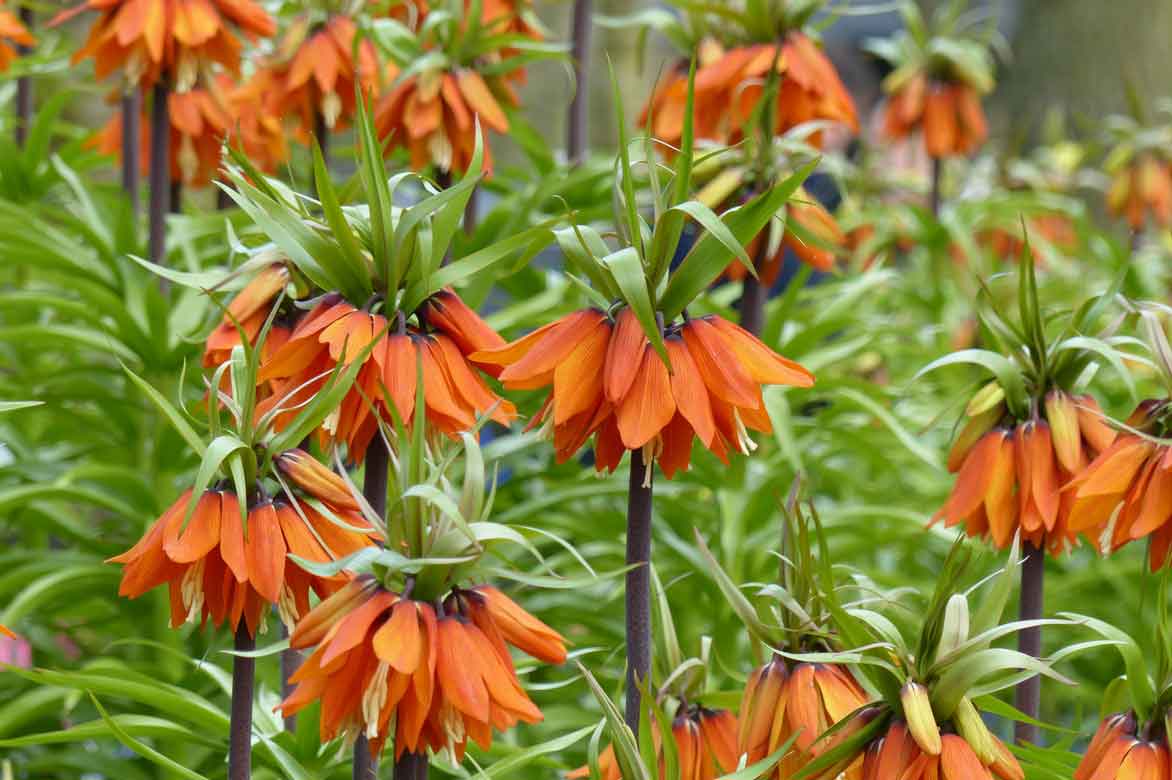
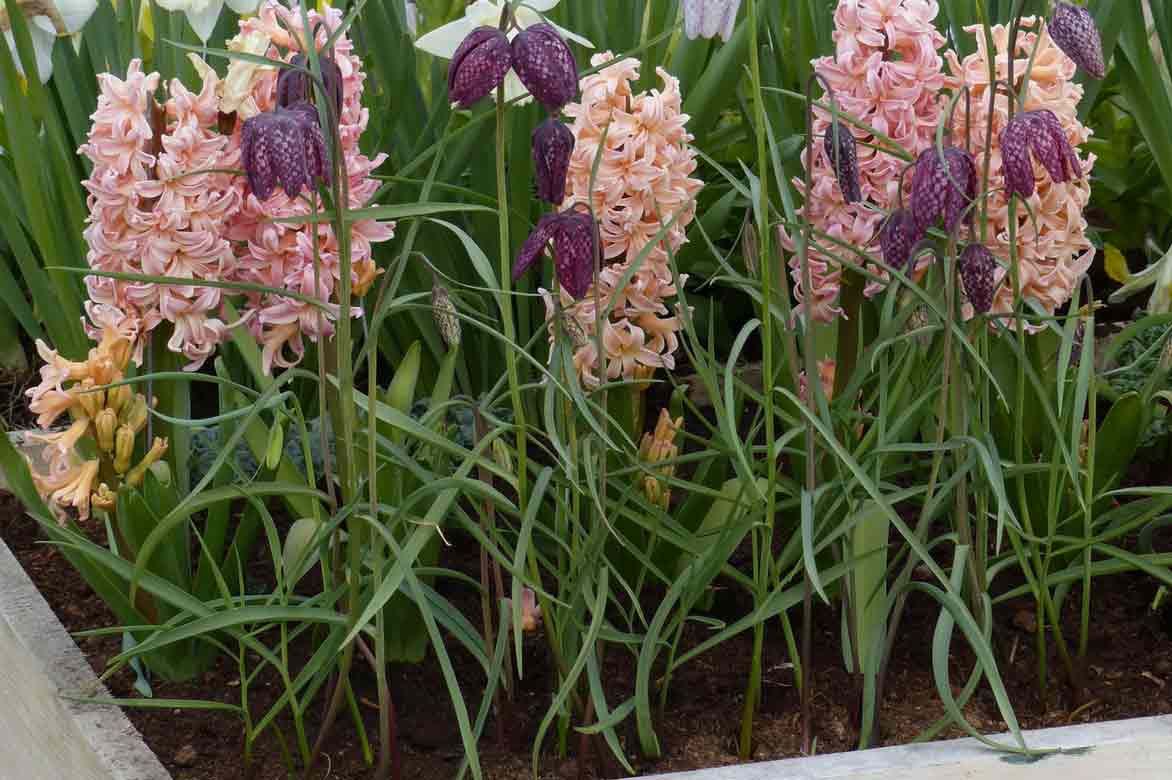

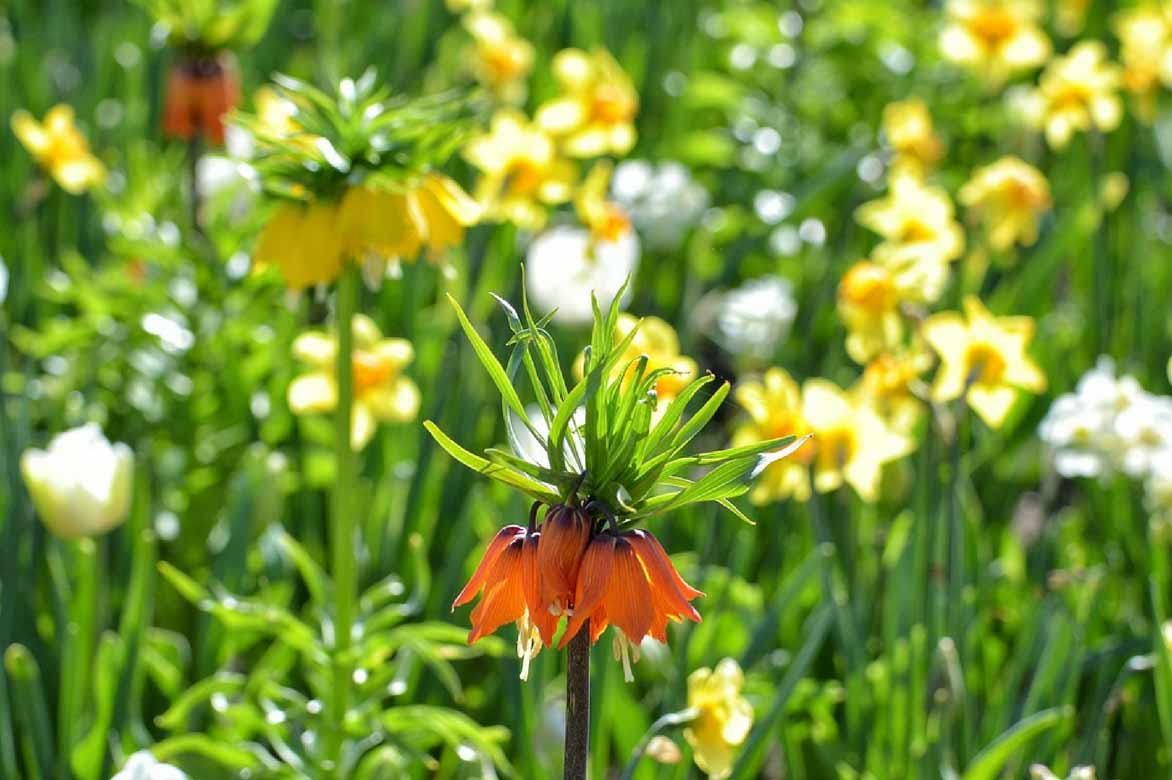
Comments